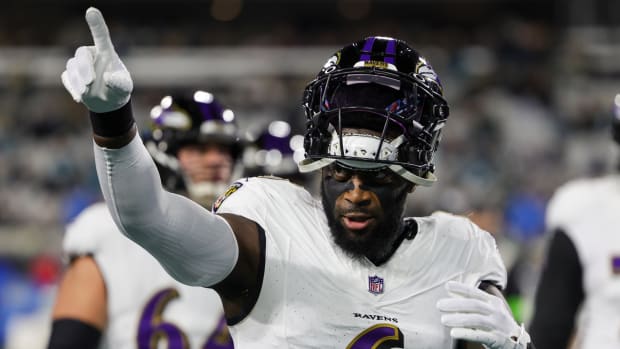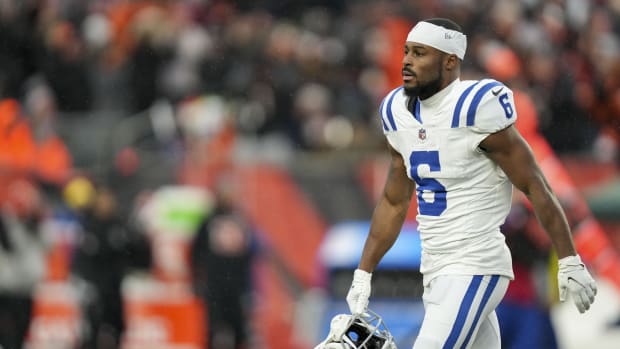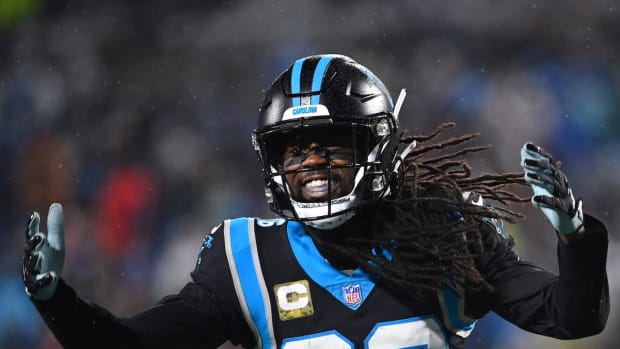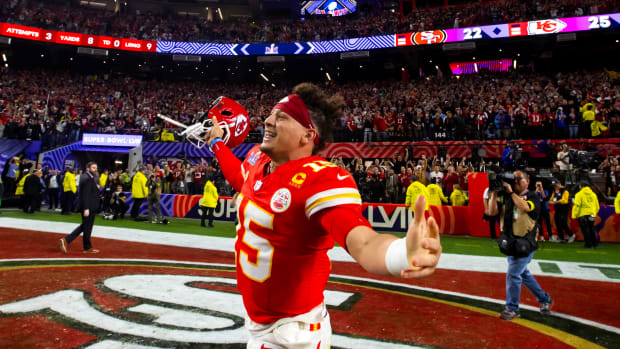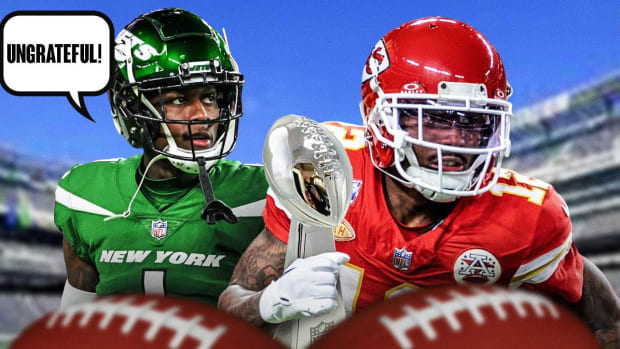NFL Quarterback Landscape Continues to Shift After Tua Tagovailoa’s Injury

Tua Tagovailoa threw for 2,840 yards and 33 touchdowns before going down with a season-ending hip injury.
Butch Dill-USA TODAY Sports
At the start of the season, there was exactly one team you could point to and say, that team is taking a quarterback next April. And even that team, the Dolphins, had a player on their roster, Josh Rosen, who could theoretically change that virtual certainty.
Things have changed plenty, and with more teams than just Miami, in the three months since.
The Titans are detaching from the second pick in 2015 draft, and the Buccaneers could do the same with the first pick from that year. The Chargers could be in play, and the Steelers seem more likely to be as well. The Patriots’ future at the position is cloudier than it’s been in decades. The Bengals and Broncos, who will be picking high, may both take a quarterback. The Panthers and Bears could also be looking for new answers under center.
Then, there’s the flip side. Tom Brady, Philip Rivers and Eli Manning are all in contract years. Cam Newton, going into a contract year, could land on the trade block. Andy Dalton probably will too and might set up as an ideal bridge quarterback for a team. Marcus Mariota and Jameis Winston could be reclamation projects for someone.
This is the landscape into which a ballyhooed 2020 draft class will be entering—one of uncertainty and moving parts, and a potential bonanza in quarterback acquisition.
So when Tua Tagovailoa went down with a season-ending hip injury on Saturday against Mississippi State, it was as much an NFL story as it was a college football story. That shifting quarterback landscape moved again with what went down at Mississippi State.
Tagovailoa has been seen as the favorite to go first overall in 2020 since the ball hit Devonta Smith’s hands on the 41-yard touchdown pass that won Nick Saban his sixth national title 22 months ago. And now, the likelihood of that happening—even though he’s thrown 76 touchdown passes against just nine interceptions since that night in Atlanta—has been greatly diminished.
“If he could’ve finished healthy, I think he would’ve been the first to go, so I do think it affects things, because there’s not a safe one now,” one AFC college scouting director said. “He was the safe one—he’s gonna be smart, accurate, he’s won at a high level, been on the big stage. Now, there’s not a safe one. There’s a lot of talent. But there’s not that one guy where you say, ‘OK, yeah, even we if don’t really hit, he’ll still pretty good.’
“Yeah, I don’t know. I’m not even sure a quarterback is the first pick anymore.”
Which means the quarterback plans for some NFL franchises could be in flux, as a result of Tagovailoa’s injury and, believe it or not, his choices going forward could further alter the timing of the aforementioned teams’ decision-making.
We’ll explain.
* * *
Week 11’s here, and so are we to get you ready for it in the Game Plan. We’re going to give you a couple Big 10 prospects to watch on Saturday, and a handful of guys to monitor over the NFL weekend, then get to your questions on …
• Tom Brady’s future, and other Patriot contractual issues.
• Philip Rivers’s prospects in L.A.
• Zac Taylor’s standing in Cincinnati.
• The Vikings’ defense.
• Current players among the top 100 all-time.
And much more. But first, we’re going to break down the Tua effect.
* * *
We’ll start with the obvious—everything hinges on the health of Tagovailoa’s hip. And right now, it looks like even the best-case scenario wouldn’t allow Tagovailoa to throw for teams in a pro-day style setting before the 2020 draft, which is a little over five months away.
With that established, I asked a handful of college scouting directors three questions—How does the class stack up now? What are Tua’s options? What is the resulting NFL fallout?—to assess the field and what lays ahead.
The QB class now
On my podcast on Tuesday, ESPN’s Todd McShay—who was on the field as part of the broadcast team when Tagovailoa was hurt against Mississippi State last Saturday—said that, as he sees it, there are two tiers of quarterbacks atop the 2020 draft class.
Tier 1: Tagovailoa, LSU’s Joe Burrow, Oregon’s Justin Herbert.
Tier 2: Washington’s Jacob Eason, Georgia’s Jake Fromm, Utah State’s Jordan Love.
The scouting directors agreed with that assessment, presuming Tagovailoa is able to make a full recovery over time. And each agreed that, for now, Tagovailoa probably drops from the top of Tier 1 to the bottom of Tier 1, still ahead of Eason, Fromm and Love, but playing catchup with Burrow and Herbert.
The sense I get is that Burrow is now the clubhouse leader. One scout said that while the LSU senior isn’t an over-the-top talent, “he has some of the stuff [Tom] Brady has—he can get away, move around in the pocket, make subtle movements to buy time. That’s hard to find, and he has that.”
Herbert, conversely, has more boom-or-bust potential. “There’s so much to like about him,” said one NFC exec. “The entire skill set’s there—tall, smart, athletic, can throw, and throw on the run. He’ll miss a few, and you ask ‘why is this happening?’ And you think maybe you clean it up, do something with his footwork. But no doubt, he’s top-five pick.”
That brings us back to Tua. Alabama coaches have compared him to Drew Brees, and scouts didn’t push back on that much—he’s shorter, a good athlete that’s not a 4.5 guy, and a deadly precise passer.
“He’s very polished, accurate, mechanically sound, and has a good-not-great arm,” one scout said. “His touch is better than his arm strength. Sometimes ball looks heavy, he doesn’t flick it like Herbert, he pushes it a little bit for me. But he’s accurate, polished, a great kid, competitive, smart. And this is not to detract from him because of his teammates, but that system, you fake the handoff, flick the slant, [Jerry] Jeudy for 60, or fake the handoff, throw the teardrop, Devonta [Smith] for 40. … If you take him out of that system, and he has to lift everyone up? I don’t if he’s that talented.”
“He’s got some sneaky arm talent, definitely a strong enough arm, about where Burrow’s is,” said another. “Where he stands out is his footwork, his ability to move around and manipulate. And more than anyone else in the class, he’s throwing with anticipation, throwing timing routes, and placing the ball where guys can go—he’s in another league from that standpoint. But everything else, his soft tissue problems, he’s a smaller guy, even just when you stand in his presence, you’d see where he’d get hurt all the time.”
As for Fromm, Love and Eason—I got the sense from some scouts that Fromm may choose to stay in school, and that the other two should. On Fromm, one evaluator said, “He’s probably the best in leadership and intelligence, with Burrow being second. He’s the best in categories you can’t measure physically. But of these guys, physically, he’s the worst of them.” More than one team has mentioned to me, by the way, that the Raiders would be one team that’d love Fromm, because of his ability to handle a lot of volume mentally.
Eason and Love, on the other hand, both have most of what you’d want physically. But Eason’s still raw, and Love’s taken a step back after a coaching change, and each would be seen as a project at this point to NFL teams.
Tua’s options
Most people think Tagovailoa has two options, but he actually has four. Here are those, with the deadline for underclassmen to declare two months away …
Stay in school: Tagovailoa could, theoretically, do this to try and build himself back up to the top of next year’s class (the first pick this year will get roughly $23 million more than the 20th pick in guaranteed money on his rookie deal). So there’s financial incentive here. But there’s also a ton of risk. First, if he gets hurt again, after the hip surgery and two ankle surgeries, he could knock himself out first-round consideration all together. Second, next year (and this is something Love and Eason have to consider too), he’d probably be battling Clemson’s Trevor Lawrence and Ohio State’s Justin Fields for position, which is probably tougher going than what he’s up against this year.
Declare and enter the NFL draft in April: The upside here: Get into an NFL building. Get the clock rolling towards a second contract. And have the shot to make the case yourself to teams along the way. This is what most scouts think he’ll do. “He should declare if he’s capable of addressing the medical concerns with team,” said one exec. “There are only three top-tier quarterbacks this year, and I’m not sure if he passes the physical that’ll he’ll fall that far. Now, if they tell him he’ll fail 20, 25 team physicals, he’s got a decision to make.”
Wait until June, and then declare for the supplemental draft: This one’s very interesting. NFL rules dictate that players have to prove changing circumstances to gain entry into the supplemental draft and, theoretically, Tagovailoa could claim improved health prompted him to enter the July version of the draft. This option would allow him to stay at Alabama, or go out on his own, to rehab, then work out for teams in June. And if a team with a top five or top 10 pick in April passes on a quarterback, maybe Tagovailoa’s health prompts them to pick him, which would help him make up the money he’d have lost going into the draft in April.
Sit for a year, get healthy, and enter the 2021 draft: The benefit here would be putting himself in the best position to be healthy ahead of the draft—focusing on it now, and protecting himself from injury by not playing in the fall. But this would mean waiting another year for a second contract, competing against Lawrence and Fields (who’d have an on-field resume from 2020), and accumulating some rust, which can be tough on a young quarterback. This option becomes more viable if his recovery timetable is longer.
So how does play out?
The fallout
If Tagovailoa declares, his draft standing will hinge largely on medical reports, and be affected by teams that, after all his history, just don’t trust that he’ll be able to stay healthy. That’s a fair concern too, when you consider how many quarterbacks with college injury history over the last decade (Sam Bradford, Jake Locker, Robert Griffin, Marcus Mariota, Carson Wentz, Deshaun Watson) kept getting hurt in the pros.
And it’d be tough for teams with all-in quarterback decisions to make, like Miami and Cincinnati, to tie their future (and job security of their coaches and scouts) to Tagovailoa. More likely would be a scenario in which a coach with job security and an established starter (New England, New Orleans) takes a swing on him later in the round, unless Tagovailoa can pass all the medical tests that he’ll face.
If Tagovailoa takes one of the other three options, and doesn’t enter the April draft, this gets even more interesting with quarterback-needy teams.
Here’s how. Say you’re one of those at the bottom of the Top 10, and would need to trade up for Burrow or Herbert. Would it make sense to sell the farm and do it? Or should you wait, knowing that Fields and Lawrence are coming in 2021, and Tagovailoa will to, either in July or with the other two the following April? A team like that could play it safe and wait, like rebuilding teams often had.
And then, there’s how all of this could affect the veteran market. If Tagovailoa was the only QB your college scouts really like, might you be more aggressive on the veteran market with, say, Newton? And if there are two or three more teams involved in the vets as a result of Tagovailoa not being available, or healthy enough, could that drive the price up on a free agent like Teddy Bridgewater, Winston or Mariota?
That’s the larger point—the possibilities are endless.
They were before Tagovailoa got hurt. They are even moreso now.
* * *
WEEKEND WATCH LIST
Seahawks DE Jadeveon Clowney: With Lane Johnson in the concussion protocol, there’s a chance that Clowney will be up against rookie Andre Dillard for much of Sunday afternoon. And while Dillard’s been impressive, this creates a nice opportunity for Clowney to build on the huge game he had against the 49ers last week.
Texans CB Gareon Conley: This could be fellow newcomer Vernon Hargreaves, who’s set to debut as a Texan on Thursday Night Football too. Houston’s deficiency at corner hurt them the first time these two met, with Jacoby Brissett hitting Zach Pascal and T.Y. Hilton six times apiece as part of a 326-yard, four-touchdown effort. And Houston conceded that in trading for Conley the next day. We’ll see if the new guys can make a difference.
Rams DL Aaron Donald: I’m fascinated to see how Wade Phillips uses him to disrupt the Ravens option game. One way to combat that kind of offense, at all levels of football, has always been to get in the backfield quickly. Donald is certainly capable of doing that.
Packers RB Aaron Jones: The Green Bay staff has paced Jones to this point, but this particular Sunday night stage might be the right place to let him loose. The Cardinals had success running the ball against a fearsome Niners front last week (135 yards rushing). And getting traction with Jones would be great way to slow the San Francisco rush down.
Patriots LT Isaiah Wynn: First game back, and New England needs Wynn, a second-year tackle, to rescue its shaky offensive line. I can’t remember a time where the Patriots were planning to lean as much on such an inexperienced player (82 snaps). But that’s where they are with DeMarcus Lawrence, Michael Bennett and Co. coming to town.
* * *
TWO FOR SATURDAY
Penn State DE Yetur Gross-Matos (at Ohio State, FOX, 12 p.m. ET): This will probably be the best offensive line that Gross-Matos faces, and it’s a chance for scouts to get a side-by-side on him with the best pass-rusher and draft prospect in the country, with Buckeye star Chase Young coming back off suspension. The 6' 5", 264-pound true junior has fought his way into the first-round conversation with a chance to continue rising—he has 6.5 sacks through 10 games after an eight-sack sophomore season.
“He’s long, fluid, can run, has good hips, a slippery pass rusher that’s only going to get stronger and more powerful,” one AFC exec said. “He’s not a great run defender yet, needs to get stronger, doesn’t play with high intensity all the time. Big-time flash player last year but looks like he’s been more consistent this year.”
Add that to the overwhelmingly positive impression that scouts have taken from school calls to Penn State on Gross-Matos, and with a good finish, and a good spring, it’s not crazy to think he could be picked in the top 15 or so.
Iowa OT Tristan Wirfs (vs. Illinois, Big Ten Network, 12 p.m. ET): A strong junior year has propelled Wirfs into a likely spot somewhere in the first half of the first round—he may be better than any of last year’s offensive line prospects were. And while Illinois isn’t exactly flush with talent, it is a chance to go against a defense, run by Lovie Smith, with an NFL bent to it, and do it with, in all likelihood, three games left in his college career.
“Really talented,” an NFC scout said. “Strong and athletic, physical with good technique. He does a great job of running off the ball and getting movement. Really natural in pass pro.”
It doesn’t hurt that he comes from Kirk Ferentz’s Iowa program (seven ex-Hawkeye offensive linemen are on NFL rosters right now), giving teams confidence that, because of his pedigree, the floor is high here. He’s been compared to Titans OT Jack Conklin—it might not blow you away, but Conklin’s problems have been most injury-related, and he was the eighth pick in the draft four years ago.
* * *
MAIL TIME!
From Dave C. (@painterbytrade): Is Brady staying with the Patriots next year?
Dave, I think so. There will be a lot of posturing between now and March, and this is without question the closest he’s coming to having to make a call of leaving. He’s also brought it up on his own in the past—his third year in the league one of his best friends on the team and a team captain, Lawyer Milloy, was unceremoniously dumped just before the opener. Brady has said in the years since it showed him that no one’s above being moved.
That said, I have a hard time seeing Brady resetting. Yes, the Chargers would make some sense, with Philip Rivers a free agent and the team needing to generate buzz in L.A. Yes, the Titans have Mike Vrabel, a friend of Brady’s, and a looming quarterback need. And yes, Chicago could be interesting too.
But we have heard that Brady has been restless in the past. He was upset in 2006 when the team nickel-and-dimed Deion Branch after letting David Givens walking in free agency. His own contract negotiation went a little sideways in 2010. Things weren’t great a couple years back. And he’s always come back.
I have doubt over whether, unless forced, he’d have the stomach to leave. And I do think the Patriots will need him in 2020, and the Krafts will make sure he gets a competitive offer.
From Blondie (@blondie6332): Does Zac Taylor have a future with the #Bengals, even if they go winless? FWIW, I think he should be afforded another season given the glaring lack of talent on the active roster.
Blondie, yes. No question. When you hire a 35-year-old coach, you have to allow for growing pains, and Taylor’s certainly had his. But the things that the Cincinnati brass liked in him—his people skills, his organization—are still there.
The next step is reworking the roster. There’s a level of disappointment in the coaching staff with how the group has performed, and a belief that big-time change is needed. Outside of this year’s rookie class, Geno Atkins, A.J. Green, Tyler Boyd, Joe Mixon and William Jackson are legitimate building blocks, and that may be it. And Atkins and Green are both 31 years old.
Maybe the rebuild will kick into high gear with a quarterback. Maybe it’ll be Chase Young. This is for sure—whatever the Bengals do atop the draft will be just one piece of a much larger renovation of the roster.
From SB LIV #SKOL (@MadCityViking): Have you watched enough of the Vikings defense to know what the heck happened to our pass defense? Griffen and Hunter among leaders all year in hurries, so it shouldn’t be the pass rush. Rhodes and Waynes just take giant steps back?
MadCity, I think you’re on it. The Vikings got offers on both Xavier Rhodes and Trae Waynes in the offseason, and that they didn’t hang up right away on those teams may indicate that they knew some level of regression was coming at that position. And to be as multiple as Mike Zimmer wants to be up front, you have to be good on the back end.
Given how many big contracts Minnesota has on the books, it’s hard to see them being huge free-agent players at corner. I’d bet they invest plenty on getting the position right in the draft, which doesn’t help much right now. For now, they’ll have to make it work with what’s there, which Zimmer’s pretty good at (even if hasn’t looked great 100% of the time).
From Stephen Sheehan (@StephenPSheehan) The Patriots’ two best players throughout the season (and arguably dating back to 2018) have been Joe Thuney and Kyle Van Noy. Both are set to hit free agency after the season. Does Belichick bring back one, neither or both? What will the market be for each?
Stephen, I’m certain that the Patriots would love to have both guys back. Their positions are the problem. Both the offensive line and linebacker tags will exceed $14 million in 2020, and doing a deal with either before we get to the tag deadline is complicated by where the market has gone at their positions.
Andrew Norwell reset the guard market in breaking $13 million per in 2018, going from Carolina to Jacksonville, and Dallas’ Zack Martin got at extension at $14 million a few months after that. Meanwhile, Kwon Alexander and Anthony Barr ($13.5 million per), C.J. Mosley ($16 million per) and Bobby Wagner ($18 million per) have, in succession, all reset the bar for off-ball linebackers in 2019.
So if I’m Thuney or Van Noy, and the Patriots don’t beat those numbers, I’m sitting tight and hitting the market in March, on the bet that I don’t get tagged. And even if either does, having a tag of more than $14 million gives a player a pretty good negotiating position on a long-term deal.
From T.J. (@tmajr3): Is Antonio Brown signed to a team by the deadline so that he is playoff eligible?
I doubt it. The league’s let his situation hang out there unresolved—without giving anyone a clue on whether or not he’d go to the commissioner’s exempt list if he was signed—and I don’t think any of it is by accident. My sense is the league doesn’t want his situation resurfacing in the news as we get closer to the playoffs, and doesn’t want to have to worry about something else coming up (always a possibility with Brown.)
With that nudge from the league, I think he’s done for 2019. We’ll see about 2020.
From mm (@meek858): Is Philip Rivers the Chargers’ quarterback in 2020?
MM … maybe. Watching Rivers the other night was tough—the four picks gave a window into a player whose body may be struggling a little right now to cash the checks his mind is writing. But I’m not sure he’s finished. Moreso, I think he’s moving into the John Elway-with-Mike Shanahan phase of his career. That is to say, he can’t lift the players up around him the same way he could, but he can still be a good player if things are right around him.
Along those lines, his tackles on Monday night: Trey Pipkins and Trent Scott. Anyone wondering why Frank Clark had his best game thus far as a Chief?
From Matt Ramas (@matt_ramas): What do you expect will happen with the appeal hearing for Myles Garrett? Will the league define the number of games he sits down beyond this year?
I think you hit on the key, Matt—the union is arguing that for a violation like this, you can’t levy an indefinite suspension, because that is essentially banishment (necessitating reinstatement from the commissioner). The PA also pointed to the precedent of the Vontaze Burfict and Antonio Smith cases to show that Garrett’s suspension was excessive.
I think he’ll win on the former and get a hard number for his suspension. But my guess would be, on the latter, he winds up with the six-game penalty standing, taking him out for the rest of the season. We’ll see.
From E.R (@edrotella): Who are three non-quarterbacks playing today that are, without a doubt, top 100 players of all time?
Without having a full list in front of me … Larry Fitzgerald. J.J. Watt. Adrian Peterson.
Aaron Donald’s a fourth. Von Miller and Earl Thomas could be in the mix too.
From Ambassador of Kwan (@JCZERN): Can Kirk Cousins win the NFC?
By himself? No. If Stefon Diggs and Adam Thielen and Kyle Rudolph stay healthy, and Dalvin Cook keeps his pace, then sure. I think this year’s Vikings team might be better than the 2017 Vikings, and that Vikings team was one egg-laying separated from playing the Super Bowl at home.
From Bryan Gnieski (@gnieskib): If teams such as the Ravens have less success offensively against a defense the second time around, why doesn’t the game plan change? Seems like Jackson has enough arm talent, recognition, good line play and pass catching weapons to add passing option wrinkles.
Bryan, the easy answer is that it has changed. As defenses get adjusted, some of the 50-yard runs from Jackson become seven- or eight-yard runs, and as long as Jackson is improving as a passer and protecting himself physically, that’s OK. And he’s done both.
The offense isn’t a gimmick. It’s like anything else in the NFL—the coaches have to keep evolving it, and the players have to be adaptable enough to keep making it work. So far, both Jackson and Roman have been up to the task.
Question or comment? Email us at talkback@themmqb.com.

































